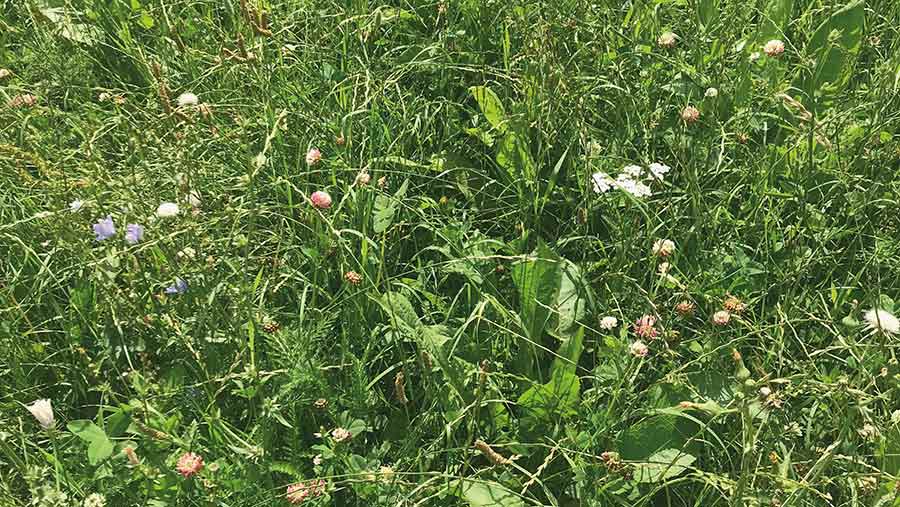How planting herbal leys can slash concentrate feeding
Planting legume and herbal leys as part of mid-tier Countryside Stewardship has enabled Wiltshire farmer Jamie Feilden to grow more quality forage and save around £7,000 a year in concentrate.
The GS4 mixes have also delivered an added payment bonus of £309/ha (see box below).
They’ve also proved drought-tolerant, while the herbal element has played a part in eliminating the need to worm lambs.

Jamie Feilden © Beth Feilden
With the government encouraging farmers to enrol in Countryside Stewardship in its “The Path to Sustainable Farming” (PDF) document, such experience is proof that these types of leys can deliver for both the environment and farm profitability, he says.
See also: Advice on establishing and grazing herbal leys
Farm Facts: Hill House Farm, Box, Bath, Wiltshire
- 24ha (60 acres) owned and 81ha (200 acres) rented
- Home of the children’s charity Jamie’s Farm
- 350 predominantly Lleyn and Suffolk ewes
- Breeds pedigree Texel tups
- 120 lamb in January and 230 in March
- Most lamb is sold through local butchers with some going to Dunbia and ABP
- 30 pedigree Aberdeen Angus suckler cows
Mr Feilden says the mixes have had a “profound” impact on the farming system at Hill House Farm.
“We felt there was the opportunity there to farm in a better way and generate income,” he explains.
“We wanted to produce better-quality grazing and forage ourselves and it’s allowed us to increase our stocking and reduce our bought-in feed bill. It’s not done from an idealistic perspective, it’s done from a commercial point of view, and it’s performing.”
About the mix and its benefits

© Jamie Feilden
Mr Feilden reseeded 10ha (25 acres) of the farm’s perennial ryegrass and white clover leys with a GS4 mix from Cotswold Seeds about 18 months ago.
This mix includes red and white clovers, birdsfoot trefoil, sainfoin, chicory, burnet forage herb, yarrow, sheeps parsley and plantain.
The old ley was sprayed off with glyphosate, lightly disced, power-harrowed, rolled once, drilled with a combi-drill and rolled again. The mix was sown at 15kg/ha (6kg/acre).

© Jamie Feilden
Ewes and lambs from the March-lambing flock are rotationally grazed on the mixes.
The fact the leys are of such high quality has eliminated the need for concentrate feeding in the month post-lambing compared to when ewes and lambs were grazed on permanent pasture.
The amount of concentrate fed to twin- and triplet-bearing ewes in the four weeks prior to lambing has also halved thanks to the availability of GS4 silage which is fed instead of hay.
GS4 legume and herb-rich swards
- GS4 legume and herb-rich swards are one of several Countryside Stewardship mix options available for farmers in mid and higher tiers
- The mixes are designed to provide a habitat and food for invertebrates and improve soil structure and water infiltration
- Farmers are paid £309/ha
- It is an option for whole or part parcels in rotation on arable land, temporary grassland or permanent grassland that has been cultivated and resown within the past five years
- The mixes are planted for five years
- Average yields of around 8-9t DM/ha can be expected over the first three years
- Suitable for all classes of cattle and sheep, but particularly lamb finishing.
Key considerations:
- The swards must have at least five species of grass, three species of legumes (including birdsfoot trefoil) and five species of herb or wildflower
- Mixes must have a minimum of 10% cover of red clover and an additional minimum of 10% cover of other legumes, herbs and wildflowers
- Inorganic nitrogen fertilisers cannot be applied
- Pesticides cannot be used, except herbicides to spot treat or weed-wipe injurious weeds or invasive non-native species
- The sward must be left to rest for at least five weeks between 1 May and 31 July
- Different seed merchants/suppliers will produce their own GS4 mixes, including different varieties that meet the species criteria.
Full details on eligibility and requirements for the Countryside Stewardship Grant on the government website
Meeting requirements
To meet the requirements of Countryside Stewardship, the GS4 leys are shut up for five weeks from 30 May.
They are then cut and baled. Last year, the 10ha (25 acres) produced 135 bales (around 40 tonnes fresh weight) or the equivalent of 13.5 bales/ha (5.4/acre), which was enough to feed the whole 350 ewe flock.
The silage averaged 11 metabolisable energy (ME) and 14.5% crude protein (CP).
Mr Feilden says: “From our point of view, there’s no input at all on that. The costs of growing it are minimal and we get the payment too.”
Lambs move on to the silage aftermaths after weaning for finishing. Mr Feilden says: “Almost all of the lambs are away by October. Because of the quality of the grass, we’re not having to carry lambs through the winter.”
This has reduced lamb concentrate feeding through the winter equating to a feed saving of between £1,500 and £2,250.
The leys are now in their third year, but are still productive, with red clover levels still high enough to meet requirements.
The GS4 mixes have proved so successful that Mr Feilden paid to establish a further 16ha (40 acres) on rented ground in September 2020.
As the landlord will receive the £309/ha payment from Natural England, Mr Feilden says there has been a “compromise” on the rent.
Tips to get the most from GS4 mixes
Francis Dunne of Field Options shares his top tips for maximising the productivity of GS4 mixes:
- Assume you will need to establish twice in the five years. It is likely that the mix (or specific species) will need to be re-established within the five-year period to maintain the required proportions of species. Red clover, in particular, is at risk of dying out. Choose a quality mix that includes a persistent red clover variety, avoid high stocking densities, rotational graze and keep off it from September to maximise longevity. But assess the crop regularly and plan to reseed in the third year, just in case.
- Think about when you sow. Some species are slow to establish and need a significant period to develop. Red clover is particularly sensitive to the drilling date. In most cases, the ideal sowing period runs from the start of April until the end of August. The mix needs to be well-established and grazed ahead of the winter.
- Rotationally graze. These leys are not suited to set-stocking. Rotational graze to provide a sufficient rest period is essential to maximise longevity.
- Shut up early in the compulsory rest period. Shut leys up at the start of the compulsory rest period (1 May) and cut for silage five weeks later. Shutting up later will mean the chicory is more likely to bolt and the mix will be of lower quality.
